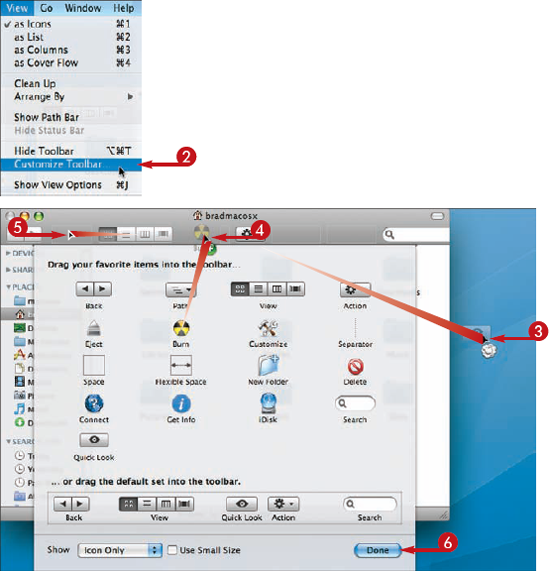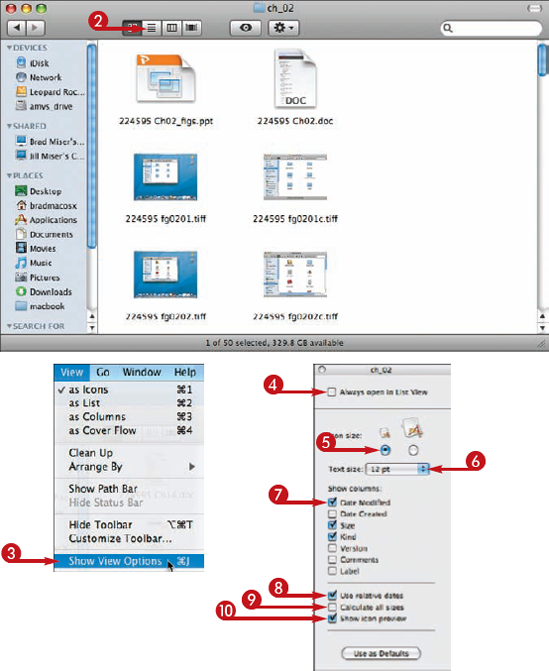
Everything you see on MacBook's desktop is viewed through some type of window (in fact, the desktop itself is a window). As you learn to use your MacBook, you will want to know how to make the most of each kind of window. The windows with which you will spend most of your time are the Finder, application, and document windows.
Like windows in the physical world, windows on MacBook enable to you to view objects onscreen, such as folders, files, and documents.
In Mac OS X, most windows have common elements that are the same no matter what application you are using. In some cases, particularly with games and utilities, you might not see document windows when you run an application; instead, you see windows specific to the functions of those applications.

Understand Finder, Application, and Document Windows
Shows the name of the folder you are currently viewing
Contains tools to control windows, move among them, change views, and perform actions
Enables you to search for files or folders
The contents of the folder you are viewing appear within the main part of Finder windows
Contains icons for locations; click an icon to view its contents in the window or open it if it is a document
Displays status information for what you are viewing, such as available disk space
Enable you to move up or down or left or right within a window to see all of its contents
Drag this handle to change the size and shape of a window
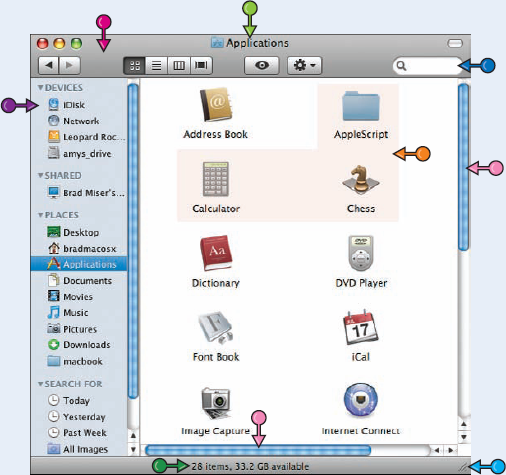
The name of the document being shown in the window or the application's
Enable you to close, minimize, or maximize the application
Provides buttons for specific actions in the application
The main window of the application presents the tools and actions for which you can use it
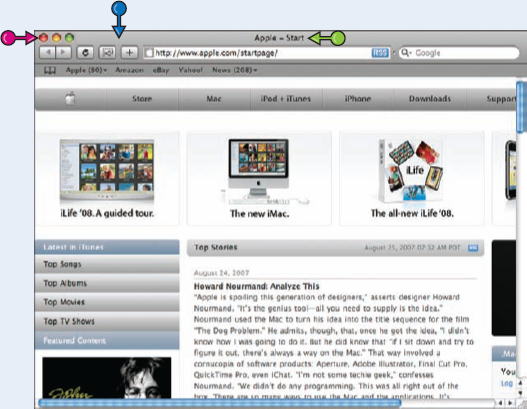
The name of the file being shown in the window
Enable you to move up or down or left or right within a window to see all of its contents
Most applications provide tools in their windows that are specific to windows they create
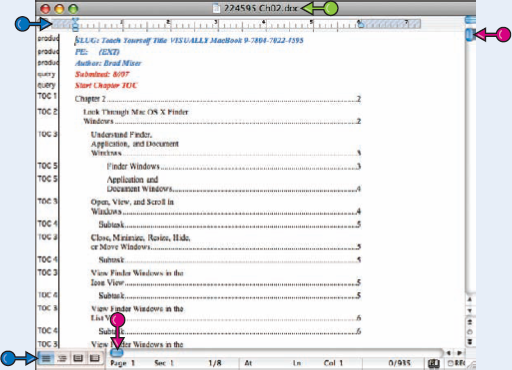
To work with documents, files, and folders, open a window that shows what you want to work with. You can scroll within an open window to view its contents.

Open, View, and Scroll in Windows

Note
You can learn a lot more about finding items on MacBook later in this book. For now, use any icon you see on the desktop.

A window showing the contents of the file or folder opens.
OPEN WINDOWS FROM THE DOCK OR SIDEBAR


The icon's window opens.

OPEN WINDOWS WITH KEYBOARD COMMANDS


The icon is highlighted to show you that it is selected.

The icon's window opens.
Note
There is yet another way to open a window for an icon. Point to the icon, press and hold the


Note
You can tell if everything within a window is shown by the scroll bars, or lack thereof. If a window does not have scroll bars, you are seeing everything that window contains.


Note
You can also scroll by clicking the arrow buttons that appear at one end of each scroll bar.
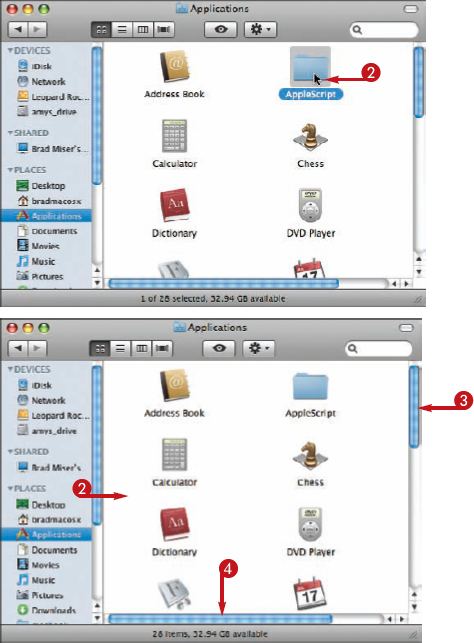
Tip
Why are scroll bars different sizes?
The relative size of the scroll bar indicates how much of the window's content you are currently seeing. If the scroll bar almost fills its space, you are seeing most of the window's content. If the scroll bar is very small compared to its space, you are seeing a smaller part of the window's contents.
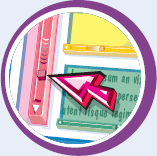
Can I use the keyboard to scroll in windows?
Yes, in several ways. If you press the Tab key, you jump from icon to icon. As you move to icons that do not appear on the screen, the window scrolls to show the icon you have moved to. You can press Shift+Tab to move in the opposite direction. You can also use the arrow keys in the same way. If you press and hold the fn key while you press one of the arrow keys, you scroll by an entire window in the direction of the arrow key your press.

As you use MacBook, you work through many windows. Some you leave open and others you close. Some you want to hide or minimize. Developing good window-management skills makes you a much more effective MacBook user.
When you are done working with a window, close it. If you want to leave a window open but do not want it taking up desktop space, minimize (shrinking the window and moving it onto the Dock) it. You can also resize open windows and move them around the desktop.
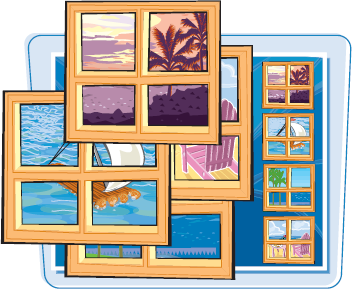
Minimize, Resize, Move, or Close Windows


The window returns to the size and position it was when you minimized it.




The window increases to its maximum size.



The window closes. If you close a document window and you have not saved changes, a prompt appears.
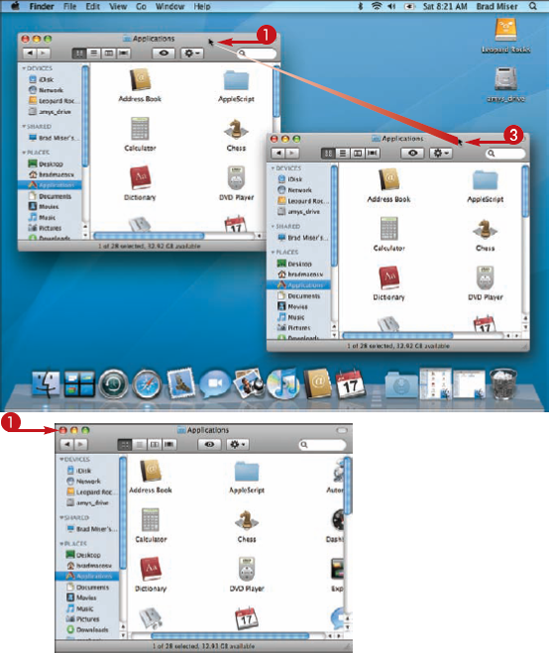
Tip
Can I use keyboard commands to manage windows?
To close a window using the keyboard, press

What is the purpose of the Window menu?
Most applications provide a Window menu that enables you to work with the application's windows. This menu typically includes a selection for each window that is open within that application; choose the window you want to view and it jumps to the front. You can also cycle through all the application's open windows and choose the Minimize command to minimize an open window.
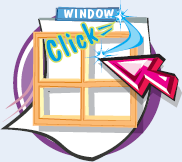
The Icon view is one that is most synonymous with Mac computers. Icons are pleasing to look at and visually indicate what kind of object they represent, such as a file or folder.
The Icon view is not the most useful one, but it is pretty.

View Finder Windows in Icon View


The objects in the window are shown as icons.










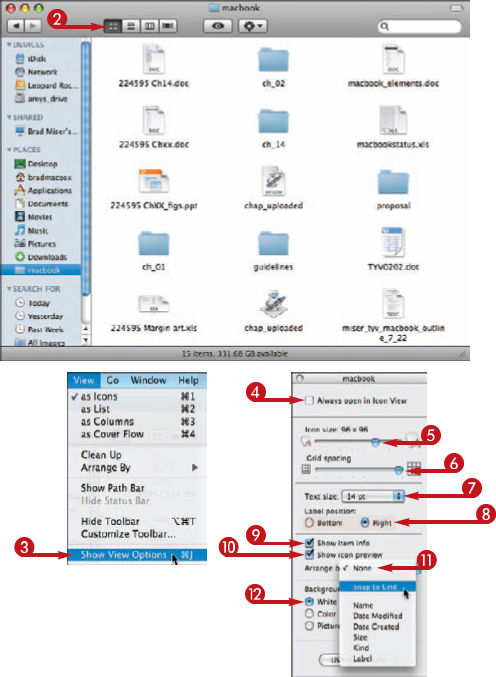


The Color Picker appears.


The Color Picker closes and you move back to the window.

The Select button appears.



The dialog box closes and the image is applied as the background to the window.


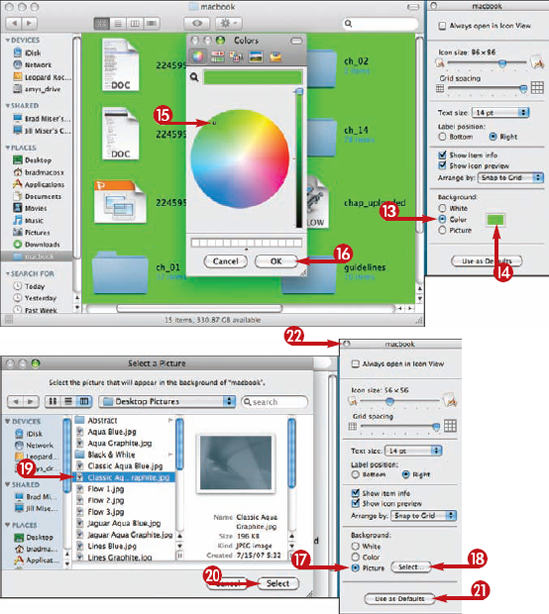
The Icon view is pretty, but it does not provide a lot of information about the files and folders you see. Even if you make the icons small, they take up a lot of room, making it hard to see all the contents of a Finder window.
List view may not look as nice as Icon view, but it does provide a lot more information. Plus, you can more easily sort windows so the items appear in the order you want.
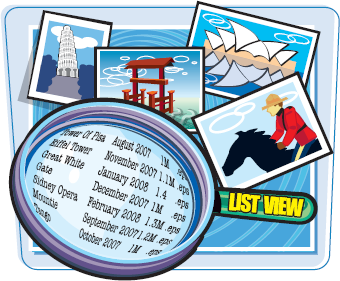
View Finder Windows in List View

Tip
How do I expand all the folders within a window at the same time?
Press and hold the Option key while you click a folder's expansion triangle. The folder expands along with all the other folders in the window and all the folders contained within those folders. Press and hold the Option key and click one of the expansion triangles to collapse all the folders again.

How do I tell where a folder is when I view its window?
Click View and then Show Path Bar. A bar appears at the bottom of the window that shows you the path from the startup disk to the location of the current folder.
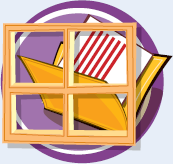
The Column view is best for navigating quickly around MacBook. This view allows you to see the contents of folders along with the locations of those folders. You can click any folder's icon to immediately see the contents of that folder in the same window.
As you learn to use MacBook, get comfortable with the Column view so you can use it to quickly move to any location.

View Finder Windows in Column View


The objects in the window are shown in columns.

The View Options dialog box appears.




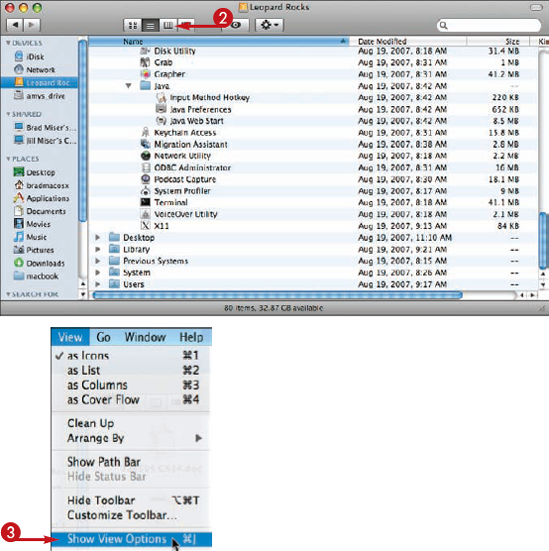






You see information about the file in the far right column.

The column resizes immediately.
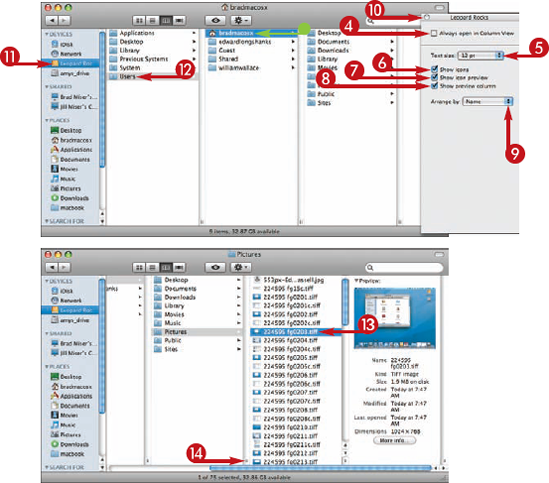
Tip
How do I resize all the columns at once?
Press and hold the Option key while you drag one column's Resize handle. All the columns are resized at the same time.
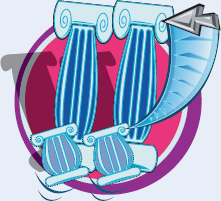
How do I tell the difference between a folder and a file?
In Column view, folders always have a right-facing triangle at the right edge of their column. Files do not have this arrow.

Cover Flow view is modeled after the iPod interface on iPhones.
The easiest way to think about the Cover Flow view is to visualize a stack of CDs that you flip through to see each CD. A Finder window in Cover Flow view behaves similarly. You can flip through the various folders and files to browse them in the top part of the window. In the bottom part of the window, you see the items in List view.
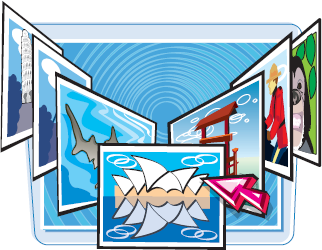
View Finder Windows in Cover Flow View


The objects in the window are shown in columns.

The View Options dialog box appears.



As you drag, each item flips by. The item currently selected is the one directly facing the screen.

It becomes selected and moves to the center of the flow view.


The Finder's Sidebar makes it easy to get to specific locations on MacBook. It comes with a number of default locations, but you can add items to or remove them from the Sidebar so that it contains the items you use most frequently.
The Sidebar is organized into sections. Devices includes volumes and devices mounted on MacBook, such as hard drives, an iDisk, iPods, and so on. Shared include those you are accessing on a network. Places contains folders and files. Search For presents saved searches.
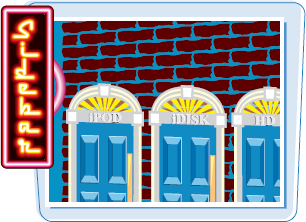

Note
When you remove something from the Sidebar, it is not removed from the computer. The item remains in its current location on MacBook; it is just no longer accessible from the Sidebar.


The item's icon is added to the Sidebar and you can use it just like the default items.



The Action pop-up menu is a powerful element of Finder windows, though you might not think so to look at it. This menu contains a list of contextual commands that you can use.
The Finder's Quick Look command enables you to view the contents of a file or group of files without actually opening them. This can save time, especially when you are looking for specific files on the desktop.
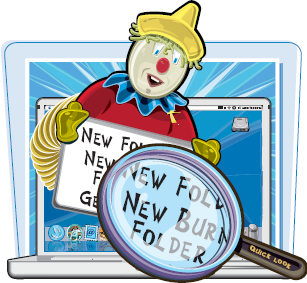
Use the Action Pop-up Menu and Quick Look
USE THE ACTION POP-UP MENU


The list of available commands appears.

The action you select is performed.
USE QUICK LOOK
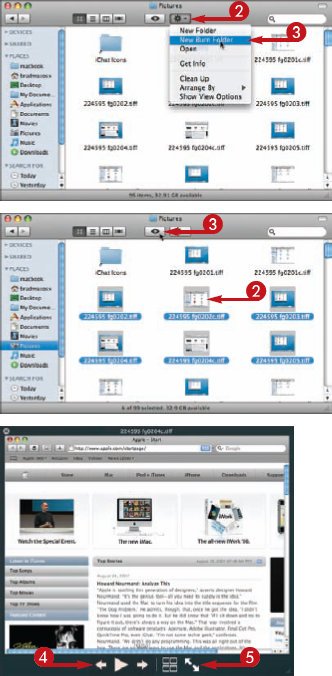
As discussed earlier, the toolbar that appears at the top of the Finder window contains buttons that you can use to access commands quickly and easily. It includes a number of default buttons. However, you can configure the toolbar so it contains the buttons you use most frequently.

Configure the Finder Window Toolbar
